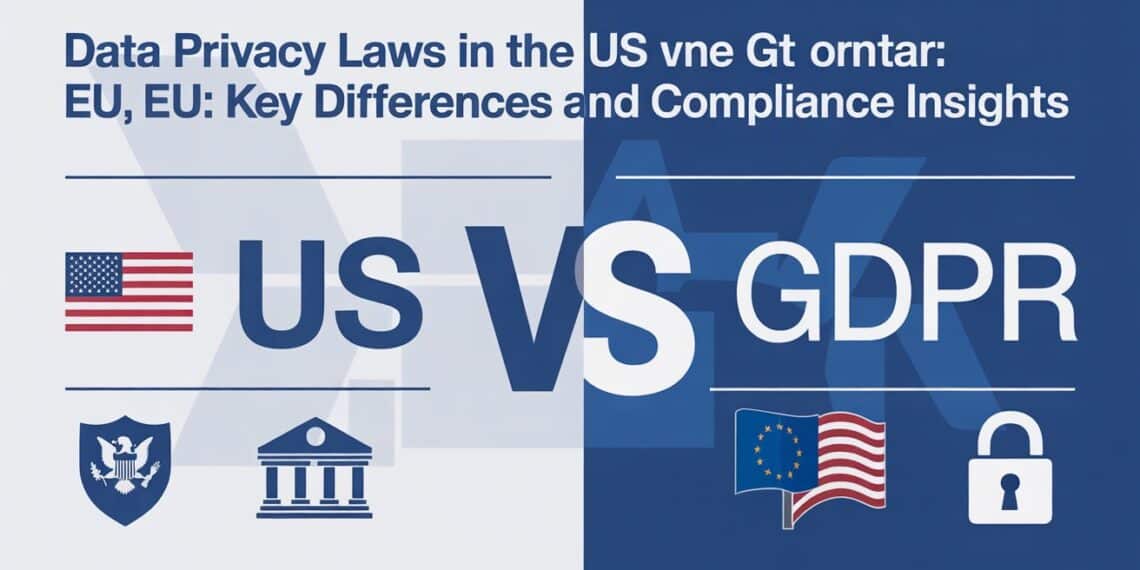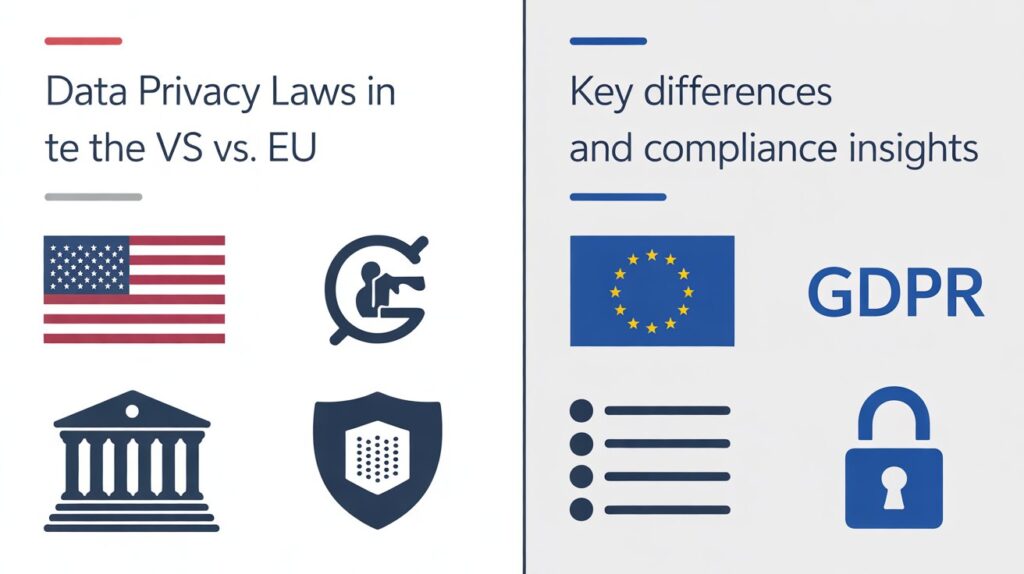In today’s digital economy, data is the new currency — but with that power comes enormous responsibility. The way personal information is collected, stored, and shared has profound implications for privacy, consumer trust, and global business operations. Nowhere is this more evident than in the contrasting frameworks of Data Privacy Laws in the US vs. EU.
While both the United States and the European Union recognize the importance of protecting personal information, their approaches differ dramatically. The EU enforces a unified, stringent data protection regime under the General Data Protection Regulation (GDPR), while the US follows a fragmented, sectoral model defined by state and federal laws.
This article examines the key differences between these two privacy systems, their enforcement mechanisms, and how organizations can navigate compliance when operating across both jurisdictions.
Understanding the Foundations of Data Privacy Laws
What Are Data Privacy Laws?
Data privacy laws are legal frameworks designed to protect individuals’ personal information and govern how organizations handle it. They define what constitutes personal data, who owns it, and under what circumstances it can be collected, processed, or shared.
The Role of Privacy in the Digital Age
In an era of mass data collection and artificial intelligence, privacy has become both a consumer right and a business imperative. Data breaches, cyberattacks, and misuse of information have pushed regulators to implement stricter rules to safeguard individual freedoms while promoting innovation.
The European Union’s Approach: The General Data Protection Regulation (GDPR)
The EU’s data protection landscape is centered on the General Data Protection Regulation (GDPR), which came into effect in May 2018. It is widely regarded as the gold standard for privacy regulation worldwide.
1. Unified Framework Across the EU
Unlike the US, the EU maintains a comprehensive, harmonized approach to data privacy. The GDPR applies uniformly across all 27 member states, ensuring that businesses face consistent obligations regardless of where they operate within the EU.
2. Core Principles of GDPR
The GDPR is based on seven key principles:
-
Lawfulness, fairness, and transparency
-
Purpose limitation
-
Data minimization
-
Accuracy
-
Storage limitation
-
Integrity and confidentiality
-
Accountability
These principles govern how organizations must handle personal data throughout its lifecycle.
3. Individual Rights Under GDPR
GDPR grants EU citizens extensive rights, including:
-
Right of access: Individuals can request access to their personal data.
-
Right to rectification and erasure: Known as the “right to be forgotten.”
-
Right to data portability: Allows users to transfer data between providers.
-
Right to restrict or object to processing: Gives individuals more control over how their data is used.
4. Enforcement and Penalties
The GDPR imposes strict penalties for noncompliance, with fines reaching up to €20 million or 4% of a company’s global annual turnover, whichever is higher. Supervisory authorities across EU member states are responsible for enforcement, making the regulation both powerful and uniform.
The United States’ Approach: A Patchwork of Sectoral and State Laws
The U.S. takes a decentralized approach to data privacy. Rather than a single federal law equivalent to the GDPR, the U.S. relies on a combination of sector-specific federal laws and state-level privacy regulations.
1. Federal Privacy Laws
At the federal level, several laws regulate specific types of data:
-
HIPAA (Health Insurance Portability and Accountability Act): Protects medical information.
-
GLBA (Gramm-Leach-Bliley Act): Safeguards financial data.
-
COPPA (Children’s Online Privacy Protection Act): Regulates data collection from minors.
-
FERPA (Family Educational Rights and Privacy Act): Protects student education records.
These laws are narrow in scope, focusing on specific industries rather than personal data as a whole.
2. State-Level Privacy Laws
Over the past few years, multiple U.S. states have enacted their own privacy legislation to fill the federal gap.
-
California Consumer Privacy Act (CCPA) and California Privacy Rights Act (CPRA) — The most comprehensive U.S. privacy laws, granting California residents rights to access, delete, and opt-out of the sale of their data.
-
Virginia Consumer Data Protection Act (VCDPA) — Similar to GDPR, with emphasis on data minimization and consumer rights.
-
Colorado Privacy Act (CPA), Connecticut Data Privacy Act (CTDPA), and Utah Consumer Privacy Act (UCPA) — Emerging frameworks offering varying levels of consumer control.
Each law has distinct thresholds and definitions, creating a patchwork system that businesses must navigate carefully.
3. Enforcement and Penalties
In the U.S., enforcement primarily falls under state attorneys general and federal agencies such as the Federal Trade Commission (FTC). Penalties vary widely by state and case, typically involving civil fines rather than GDPR-style global turnover percentages.
Key Differences Between Data Privacy Laws in the US vs. EU
Although both regions aim to protect consumer data, their legal philosophies and enforcement mechanisms differ substantially. Below are the most significant distinctions.
1. Legal Philosophy and Framework
-
EU (GDPR): Treats data protection as a fundamental human right. The GDPR applies across all industries and EU countries.
-
US: Views data privacy primarily as a consumer protection issue, regulated by different laws for different industries and states.
2. Scope and Applicability
-
GDPR: Applies to any company — inside or outside the EU — that processes personal data of EU residents.
-
US Laws: Generally apply to entities operating within a specific state or industry.
3. Consent and Lawful Basis
-
GDPR: Requires a lawful basis for data processing (e.g., consent, legitimate interest, contract).
-
US Laws: Often rely on “opt-out” models, giving consumers the ability to prevent certain uses of their data but not requiring explicit consent upfront.
4. Individual Rights
-
EU: Individuals have extensive rights (access, erasure, portability).
-
US: Rights are limited and vary depending on the state or industry.
5. Enforcement Power
-
EU: Independent data protection authorities enforce the law with significant penalty power.
-
US: Enforcement is fragmented, handled by various state and federal entities with smaller penalties.
6. Cross-Border Data Transfers
-
EU: Strict rules govern international data transfers, requiring adequacy decisions or Standard Contractual Clauses (SCCs).
-
US: Relies on self-certification frameworks (such as the EU-U.S. Data Privacy Framework) to facilitate compliant transfers.
Implications for Global Businesses
For multinational organizations, navigating Data Privacy Laws in the US vs. EU can be complex and costly. A company operating in both regions must meet two very different sets of expectations.
1. Dual Compliance Obligations
Businesses must comply simultaneously with GDPR’s comprehensive framework and the patchwork of U.S. federal and state laws. This often requires:
-
Conducting data mapping exercises
-
Implementing consent management systems
-
Updating privacy notices
-
Training employees on jurisdiction-specific requirements
2. Increased Compliance Costs
Maintaining multiple privacy programs increases administrative and legal costs. Companies often need privacy officers, external audits, and ongoing monitoring to remain compliant.
3. Operational Challenges
Differences in definitions, data rights, and consent requirements complicate how organizations design data processing systems and customer experiences.
4. Risk of Fines and Reputational Damage
Violations in either jurisdiction can result in substantial financial penalties and reputational harm. Organizations must adopt proactive risk management strategies to ensure full compliance.
Achieving Compliance: Best Practices for Businesses
1. Establish a Unified Privacy Framework
Create an overarching privacy program that meets the strictest requirements — typically GDPR standards. This approach simplifies compliance and ensures consistency across markets.
2. Conduct Data Protection Impact Assessments (DPIAs)
Regularly evaluate how personal data is collected, used, and shared. Identify risks and implement safeguards such as pseudonymization and encryption.
3. Update Privacy Policies and Notices
Ensure that your public-facing privacy policy clearly discloses what data you collect, why you collect it, and how users can exercise their rights.
4. Strengthen Vendor and Third-Party Management
Review contracts with processors and vendors to include data protection clauses and ensure they comply with applicable laws.
5. Implement Strong Security Measures
Adopt industry-standard cybersecurity practices, including multi-factor authentication, encryption, and access controls, to protect personal data.
6. Appoint a Data Protection Officer (DPO)
For organizations subject to GDPR, appointing a DPO ensures ongoing oversight and communication with data protection authorities.
The Future of Data Privacy Regulation
The divide between the US and EU is gradually narrowing as the U.S. introduces more comprehensive privacy frameworks at the state level and as global businesses demand consistency.
Emerging trends include:
-
Federal U.S. Privacy Legislation: Discussions continue around adopting a national privacy law to unify state frameworks.
-
Cross-Border Data Frameworks: The new EU-U.S. Data Privacy Framework (2023) aims to streamline transatlantic data flows.
-
AI and Automated Decision-Making: Both regions are considering laws governing data used in AI algorithms, reflecting growing ethical and security concerns.
As technology evolves, so too will the laws that govern it, with transparency and accountability remaining at the forefront.
FAQs About Data Privacy Laws in the US vs. EU
1. Why are EU privacy laws considered stricter than U.S. laws?
Because the EU treats data privacy as a fundamental human right, while the U.S. views it as a consumer protection issue, leading to stricter obligations and penalties under GDPR.
2. Do U.S. companies have to comply with GDPR?
Yes. Any U.S. company processing personal data of EU residents — even without a physical presence in Europe — must comply with GDPR requirements.
3. What is the difference between CCPA and GDPR?
GDPR applies universally within the EU and requires consent before processing data, while CCPA gives California consumers the right to opt out of data sales but doesn’t require explicit consent for all processing.
4. How are data breaches handled under these laws?
GDPR requires notification to regulators within 72 hours of discovery, while U.S. breach laws vary by state and may allow longer timelines.
5. Are there plans for a unified federal privacy law in the U.S.?
Yes, proposals such as the American Data Privacy and Protection Act (ADPPA) have been introduced but not yet enacted. The debate continues as state laws expand.
Conclusion
The comparison between Data Privacy Laws in the US vs. EU underscores two very different philosophies: one centralized and rights-based, the other decentralized and market-driven. Yet both share a common goal — protecting individuals from misuse of their personal data in an increasingly connected world.
For global businesses, success lies in adopting a privacy-first mindset, building transparent data practices, and striving for compliance that goes beyond legal obligation to earn consumer trust.
As regulations evolve, one thing remains certain: privacy is no longer optional — it’s a cornerstone of responsible digital transformation.











